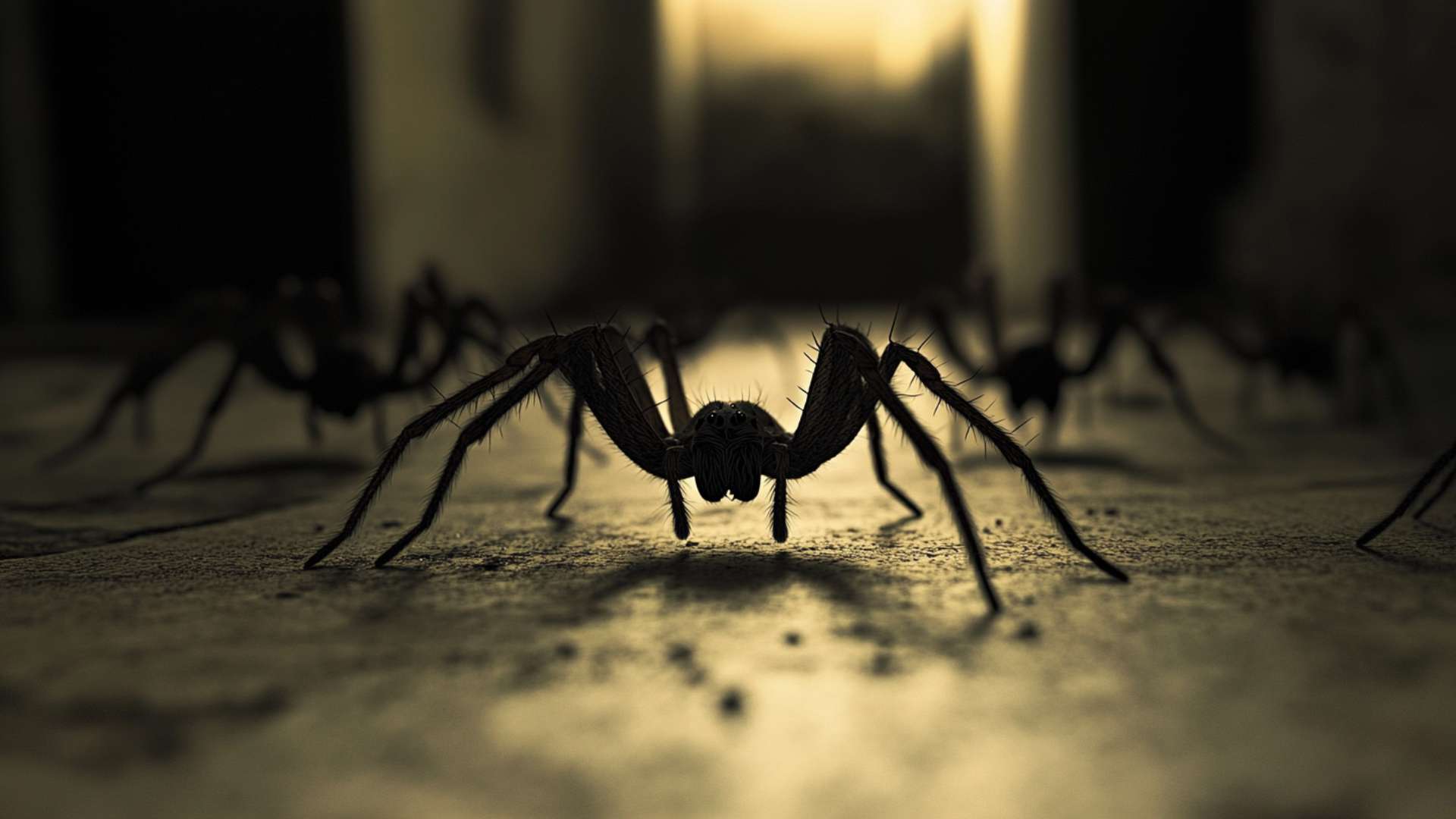Spiders, those eight-legged creatures that often inspire a mix of awe and fear, have captivated human curiosity for centuries. With their intricate webs, swift movements, and sometimes venomous nature, they possess an undeniable allure.
Whether it’s the stealthy hunting tactics of a jumping spider or the vibrant colorful body of a crab spider, these arachnids never fail to pique our interest. But one question that continues to baffle researchers and enthusiasts alike is how spiders navigate in the darkness.
The mystery of spider vision in the dark
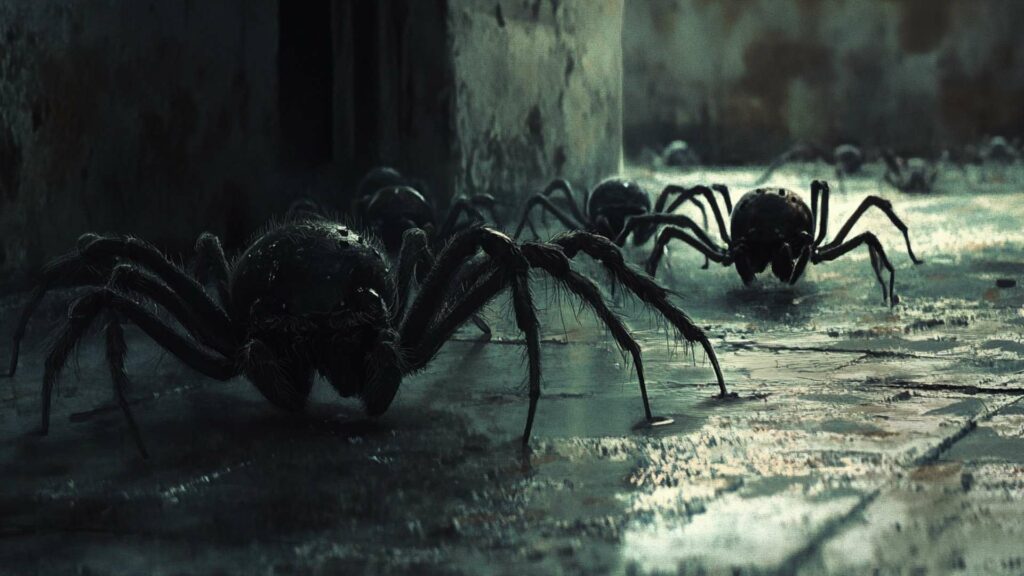
When we think about sight, our minds often conjure up images of eyes glistening in the light. However, spider vision is far more complex than what meets the human eye.
While most spiders do possess eyes (some even have eight!), scientists discovered they perceive the world quite differently from us. The ability to see in dimly lit environments remains mysterious and intriguing.
Unlike humans who rely on three types of color-sensitive cells to perceive different hues within the visible spectrum, spiders typically lack this ability. Instead, their primary eyes are adapted for sensitivity to movement and light intensity changes rather than color discrimination.
This leads us to wonder: How do these fascinating creatures navigate through darkness without being completely blind? Let’s delve into their unique sensory organs and discover how they tackle this enigmatic challenge.
Spider Vision Basics
When it comes to spider vision, we often picture them with multiple eyes, but did you know that not all spiders have the same type of eyes? Spiders can have either compound eyes or simple eyes, depending on their species. Compound eyes are made up of numerous tiny lenses called ommatidia, while simple eyes are just single-lens structures. Compound eyes, found in many spider species, provide a wide field of view and allow them to detect prey or predators from various angles simultaneously. This is particularly useful for spiders that need to be aware of their surroundings at all times. On the other hand, spiders with simple eyes have fewer lenses and a more limited field of view.
Spider’s Sensitivity to Light
Spiders possess a remarkable sensitivity to light, even in low light conditions where human vision would struggle. Their ability to see in dimly lit environments is due to the presence of specialized photoreceptor cells called rod cells. These rod cells are highly sensitive to light and enable spiders to gather even the tiniest amount of green light out of available illumination.
It’s important to note that not all spider species have the same level of sensitivity towards light. Some nocturnal hunters like wolf spiders rely on their huge secondary eyes located on top of their heads for capturing prey under moonlit skies, whereas others may have adapted differently depending on their habitat and hunting strategies.
While most human beings rely heavily on their sense of sight during daylight hours when illumination is abundant across the visible spectrum, spiders have evolved unique visual systems suited for different environments and lifestyles. The next section will delve deeper into how these fascinating creatures adapt their vision specifically for low-light conditions and how they utilize this sensory advantage in finding prey efficiently.
Tapping into the Dark: The Reflective Tapetum
When it comes to navigating the darkness, spiders have developed ingenious adaptations to make the most of their relatively poor vision. One such adaptation is the presence of a specialized layer in their eyes called the tapetum. The tapetum acts as a reflective surface that enhances a spider’s ability to detect and make use of available light sources in low-light conditions.
The tapetum is located behind the retina, at the back of a spider’s eye. This reflective layer is made up of tiny guanine crystals that efficiently bounce back any incoming light that might have passed through the photoreceptor cells on its way to being absorbed.
By reflecting this light back onto the retina, the tapetum significantly boosts a spider’s sensitivity to even the faintest glimmers in its surroundings. It seems wolf spider’s eyes are almost like having tiny mirrors strategically placed within their eyes, amplifying what little light they can gather.
The More, The Merrier: Increased Photoreceptor Cells

In addition to having well-developed tapeta, spiders have another trick up their eight-legged sleeves when it comes to seeing in low-light environments—increased numbers of photoreceptor cells. These cells are responsible for capturing and converting light into electrical signals that can be interpreted by the spider’s nervous system. Most species of spiders possess multiple pairs of principal eyes situated on their head, each with its own set of photoreceptor cells.
These primary eyes are typically arranged in different configurations depending on species and lifestyle but all serve as important visual tools for detecting motion and perceiving shapes during daylight hours. Moreover, many spiders also possess secondary eyes or smaller sets of principal eyes that are particularly adapted for night vision.
These secondary eyes often contain an increased number of photoreceptor cells compared to their primary counterparts. This abundance of light-sensitive cells allows spiders to gather as much available light as possible, maximizing their ability to perceive their surroundings in the dark.
So, can spiders see in the dark? While they may not have the best eyesight compared to other animals, spiders employ their well-developed tapeta and increased photoreceptor cells to enable them to effectively navigate and hunt during nighttime hours.
These adaptations truly highlight the remarkable precision with which spiders have fine-tuned their visual systems, allowing them to thrive even when light is scarce. Stay tuned for our next section where we explore how different spider species utilize their exceptional night vision skills for hunting and survival!
Nocturnal species and their hunting strategies
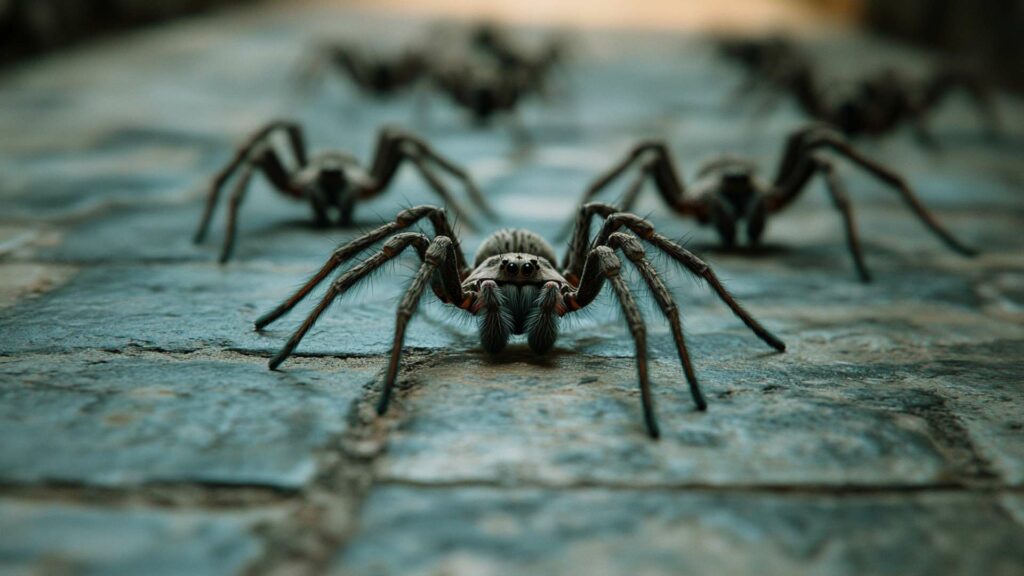
In the realm of spiders, darkness doesn’t hinder their quest for food. Many spider species have adapted to daylight hunters become efficient nocturnal hunters.
Take wolf spiders, for example. These cunning predators prowl the night, using their keen senses to detect movement and locate potential prey.
Equipped with trichromatic vision, meaning they have three types of color-sensitive cells in their eyes, they can perceive a wide range of colors even in low light conditions. This advantage allows them to spot unsuspecting insects scurrying through the shadows.
Net-casting spiders are another fascinating example of night-hunting specialists. These clever arachnids construct intricate webs that resemble a net or hammock.
By positioning themselves above the ground with their huge eyes fixated on a specific spot, these spiders wait patiently for prey to come close enough before swiftly casting their web over them. With exceptional night vision, net-casting spiders can accurately judge distances and react swiftly when an unsuspecting insect triggers their trap.
Specialized eye structures for night vision
To thrive in the darkness, some spider species have developed unique eye structures that enhance their ability to see in dim light conditions. Jumping spiders are renowned for their impressive visual capabilities and possess large frontal eyes called “median eyes.” These specialized eyes provide exceptional depth perception and allow them to accurately judge distances even during nocturnal hunts.
Additionally, other night-hunting spiders such as crab spiders have evolved eye arrangements that maximize sensitivity to available light sources. By having multiple sets or four pairs of eyes strategically placed on their heads – some facing forward while others cover peripheral vision – these arachnids can gather as much available light as possible from different angles.
Although they may not possess the best eyesight overall compared to other spider species, these adaptations enable them to navigate and find food more effectively in low-light environments. Spiders have evolved various strategies to thrive in the dark.
Nocturnal species employ hunting techniques that capitalize on their exceptional night vision and specialized eye structures. Whether it’s the trichromatic vision of wolf spiders or the unique eye arrangements of net-casting and crab spiders, these arachnids have adapted to exploit the darkness to their advantage, making them formidable predators during the night.
Silk production and web construction process
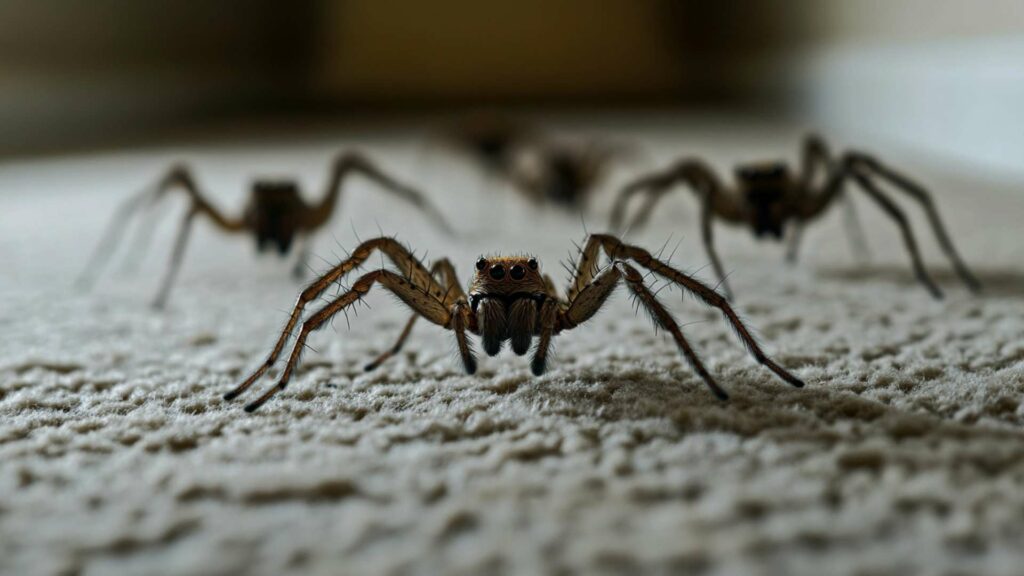
When it comes to web-building in the dark, spiders exhibit an incredible level of skill and impressive precision throughout. Silk production is a fascinating process that starts within the spider’s body.
Spiders have special glands called spinnerets located at the posterior end of their abdomen, which produce silk threads with remarkable properties. The silk is then extruded through tiny spigots present on the spinnerets, allowing spiders to manipulate it according to their needs.
To construct a web, spiders use different types of silk for various purposes. They start by creating anchor lines, which are strong and durable silk threads that attach the web to surrounding structures like tree branches or walls.
Once the framework is established, they meticulously weave radial lines from the center towards the outer edges, forming what is commonly known as “spokes” in the web structure. They build spiral threads in a spiral pattern from outside to inside using sticky silk for capturing prey.
Utilizing other senses to compensate for low visibility
Spiders are not solely reliant on vision when building webs in darkness; they rely on their extraordinary ability to sense vibrations and utilize their other senses as well. While most spiders have poor eyesight compared to humans or other animals, they possess specialized sensory organs known as slit sensilla scattered across their bodies. These slit sensilla can detect even subtle vibrations caused by approaching prey or potential predators.
In addition to vibration detection, spiders also rely on chemoreception – a sense of smell – to locate potential food sources. They release pheromones and chemical signals into their surroundings that attract insects towards their webs.
This chemical communication allows them to navigate effectively despite limited visibility in darkness. Overall, while spiders do face challenges when constructing webs in low-light conditions due to their relatively poor eyesight compared to humans’, they have evolved a remarkable repertoire of sensory abilities to compensate for this disadvantage.
By utilizing their silk production skills and employing alternative senses like vibration detection and chemoreception, spiders have adapted to thrive and capture prey efficiently in the dark. (Note: The given text does not contain any HTML tags other than header tags.
Vibrations: Detecting Prey and Predators in Darkness
In the dark corners of our world, where light fails to reach, spiders have evolved remarkable sensory mechanisms to navigate their surroundings. One such mechanism is their ability to detect vibrations. While their eyes might not be able to perceive the tiniest details in low-light conditions, spiders have developed an acute sensitivity to vibrations, allowing them to detect motion to efficiently capture prey and avoid potential predators.
When a spider feels vibrations through its delicate leg hairs, it can quickly discern the nature of the disturbance. For instance, if a potential meal scuttles nearby or an unsuspecting insect gets caught in its web, these vibrations alert the spider, enabling it to pounce upon its prey with precision.
Similarly, if a larger predator approaches, such as a lurking bat or another spider seeking territorial dominance, these vibrations serve as an early warning system that triggers defensive actions. This heightened vibrational sensitivity is especially pronounced in species like wolf spiders.
These formidable hunters rely less on vision and more on detecting subtle movements produced by both prey and predators alike. The ability to perceive these vibrations allows wolf spiders to stalk prey with excel even in pitch darkness or when deprived of their primary eyesight due to various circumstances.
Chemoreception: Using Chemical Cues to Locate Food
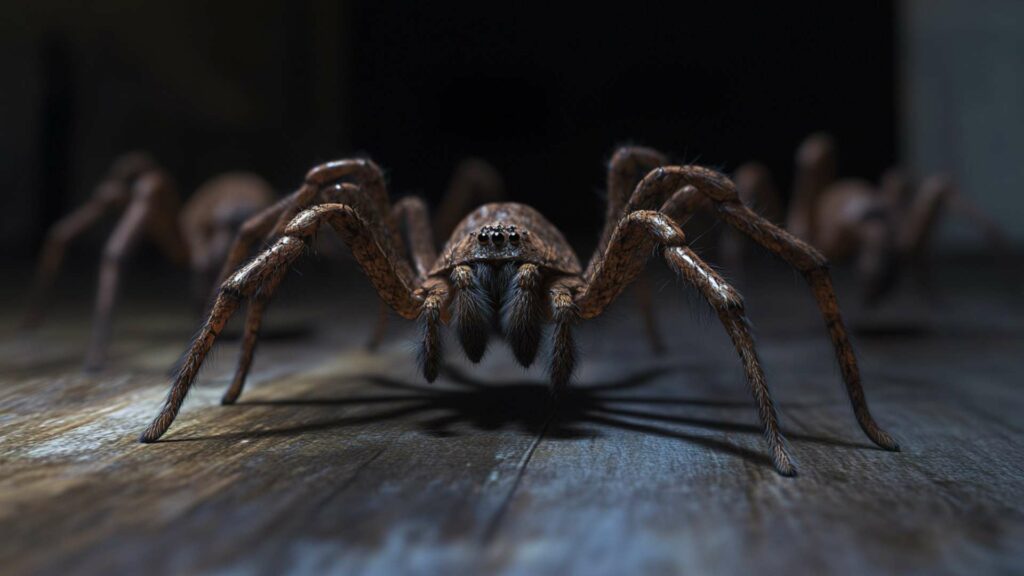
Vibrations alone do not provide a complete picture of the spider’s nocturnal world; they also heavily rely on another sense – chemoreception. Spiders possess chemosensory receptors located on appendages called pedipalps and legs that allow them to detect chemical cues present in their environment.
This remarkable ability is especially useful when it comes to locating food sources without relying solely on vision. By releasing pheromones into the air or depositing them along silk threads while building webs, spiders attract potential mates and communicate with others of their species.
Additionally, they can detect chemical signals left behind by prey or other spiders, helping them locate potential meals or avoid areas already claimed by territorial rivals. This chemoreception is highly sophisticated in flower spiders, the brightly colored arachnids that rely on attracting pollinators like bees and butterflies for sustenance.
They produce fragrances similar to floral scents, luring unsuspecting insects towards them. This cunning strategy allows flower spiders to capitalize on their poor eyesight at night and ensure a steady supply of food despite the darkness.
While spiders may not possess the same advanced color vision as humans, their reliance on vibrations and chemoreception as sensory mechanisms beyond vision enables them to thrive in the dark corners of our natural world. These incredible adaptations have allowed these eight-legged invertebrate animals to navigate through dark caves, capture prey with stealthy precision, and successfully compete for resources in often challenging environments.
Unique spider species with exceptional night vision
Net-casting spiders: Mastering precision hunting in the dark

When it comes to mastering the art of precision hunting in the dark, net-casting spiders take center stage. These incredible arachnids, belonging to the family Deinopidae, have evolved remarkable adaptations that enable them to excel in low-light conditions.
To navigate and hunt effectively at night, net-casting spiders possess highly sensitive eyes that can detect even the slightest movements. Their vision is so acute that they can spot prey, such as tiny insects or even other spiders, from a considerable distance.
Net-casting spiders have large eyes positioned at the front of their heads, with good eyesight giving them an impressive field of view. These specialized eyes are equipped with a reflective layer called tapeta, similar to those found in some nocturnal animals like cats.
This tapetum maximizes light capture by reflecting incoming light back through the retina, enhancing their ability to see in dimly lit environments. With their well-developed tapeta and exceptional visual acuity, net-casting spiders can precisely calculate distances and accurately cast their ingenious silk nets onto unsuspecting prey.
Jumping spiders: Acrobatic hunters with remarkable visual abilities
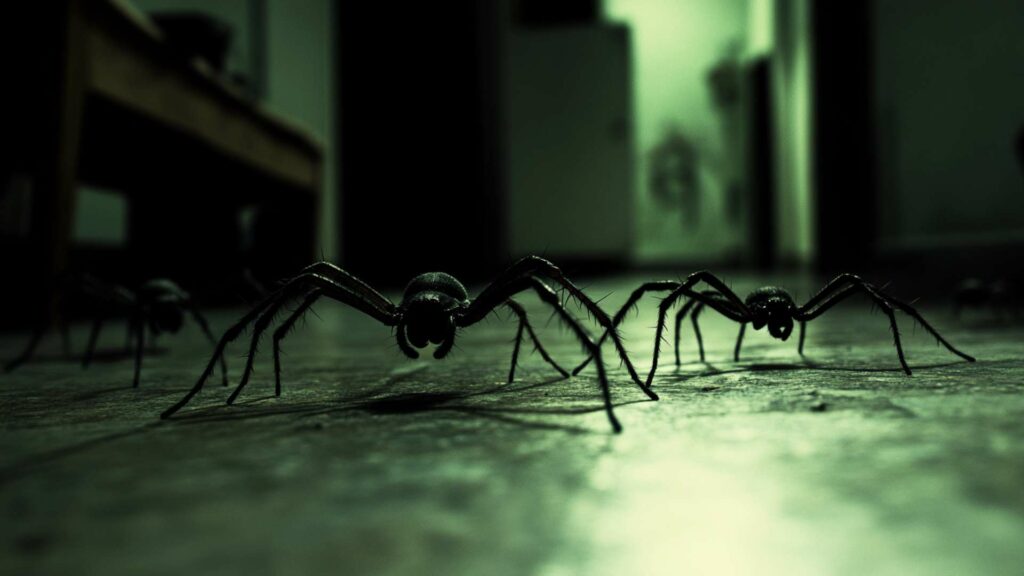
Amongst the spider kingdom’s acrobatic hunters, jumping spiders stand out for their remarkable visual prowess and agility. These charismatic arachnids belong to the family Salticidae and are known for their keen perception and advanced spatial awareness. Jumping spiders possess unique eye arrangements that give them excellent depth perception while hunting in both bright daylight and dimly lit environments.
With eight eyes and multiple pairs of large forward-facing eyes perched on top of their heads, jumping spiders have a wide field of vision that allows them to observe their surroundings meticulously. Their principal pair of eyes is particularly fascinating – these large anterior median eyes have a single lens instead of the multiple lenses seen in most spider species.
This characteristic grants jumping spiders sharp vision, enabling them to track and pounce on their prey with unparalleled accuracy. In addition to their acute vision, jumping spiders exhibit an extraordinary ability to perceive ultraviolet light.
This capacity opens up a whole new dimension of sensory input that aids in their hunting and communication strategies. By detecting UV patterns on flowers or the UV-reflective silk spun by potential mates, jumping spiders can precisely navigate their environment and attract a potential mate or partners.
Net-casting spiders and jumping spiders showcase exceptional night vision abilities that set them apart from other arachnid species. Their specialized eye structures, including well-developed tapeta in net-casting spiders and single-lens eyes in jumping spiders, contribute to their incredible visual acuity in low-light conditions.
These spiders see remarkable adaptations that allow them to thrive as acrobatic hunters capable of precisely targeting their prey through nuanced movements and keen perception. The study of these unique spider species not only sheds light on the fascinating intricacies of spider vision but also highlights the vast diversity found within the natural world’s nocturnal hunters.
Species-Specific Adaptations
Spiders are an incredibly diverse group of arachnids, with over 48,000 different species identified so far. Naturally, not all spiders have the same visual abilities, especially in low-light conditions. Some species have evolved specific adaptations to optimize their vision in the dark.
For instance, jumping spiders, known for their incredible visual acuity, possess large principal eyes that allow them to see clearly even in dimly lit environments. These remarkable hunters use their good vision to detect minute movements and accurately track down prey or potential mates.
On the other hand, not all spiders excel in low-light conditions. Wolf spiders, for instance, rely less on visual cues due to their poor eyesight compared to other spider species.
Instead of relying solely on vision to find prey or potential mates, they use other sensory mechanisms such as touch and vibrations through specialized hairs on their legs. These adaptations highlight how different spider species have evolved distinct strategies for navigating and surviving in dark places.
Environmental Conditions
While some spider species possess natural adaptations for seeing in the dark, environmental conditions also play a crucial role in determining their visual capabilities. Factors such as available ambient light and particular habitats greatly influence a spider’s ability to perceive its surroundings effectively under low light conditions.
For example, spiders dwelling in dark caves or underground burrows where light levels are extremely limited have developed unique mechanisms to cope with these challenging environments. Some cave-dwelling spiders have evolved larger eyes that can capture even the faintest traces of light available deep within underground chambers.
Moreover, ultraviolet (UV) light plays an essential role for certain spider species that can perceive this part of the light spectrum invisible to human vision. Numerous studies have shown that many flowers bear UV patterns only visible to specific pollinating spiders, acting as visual signals to attract them for potential prey or mating opportunities.
Species-specific adaptations and environmental conditions significantly influence a spider’s ability to see in the dark. While some spiders have evolved remarkable visual acuity and well-developed tapeta that enhance their vision even under low-light conditions, others rely on alternative sensory mechanisms due to poor eyesight.
Additionally, the specific environments in which spiders live dictate the level of visual adaptations needed for survival. Understanding these factors helps us appreciate the diverse strategies employed by different spider species to navigate and thrive in various light conditions.
The Dance of Perception: Humans vs. Spiders
Our perception of the world is heavily influenced by our visual system, but it is important to acknowledge that humans and spiders experience stark differences when it comes to seeing in the dark. While we rely on specialized cells known as rods and cones to perceive light, spiders have a unique visual system that enables them to navigate and hunt in low-light conditions with remarkable precision.
Understanding Differences in Visual Systems
Human eyes are optimized for daylight vision, allowing us to distinguish colors within the visible spectrum and perceive fine details. However, our ability to see clearly decreases significantly as light levels diminish.
On the other hand, spiders possess a variety of adaptations that grant them an advantage in low-light environments. Most spiders have multiple pairs of eyes located strategically on their bodies.
These secondary eyes often possess well-developed tapeta — reflective structures behind the retina — that enhance their sensitivity to light. For example, consider the striking eyes of a wolf spider or the enormous peepers of a jumping spider’s head above; these visual marvels are capable of capturing even subtle movements in near darkness.
Advancements in Studying Spider Vision
The study of spider vision has fascinated researchers for decades, leading to numerous breakthroughs that shed light on how these arachnids perceive their surroundings at night. Scientists employ various techniques such as electrophysiology, behavioral experiments, and genetic analyses to unravel the secrets hidden within spiders’ eyes.
Recent advancements have allowed researchers to investigate neural pathways and unravel how different species adapt their vision based on ecological factors such as prey preference focuses light or habitat darkness. By delving into this complex realm of arachnid perception, scientists hope not only to unravel fascinating mysteries but also gain insights into potential applications for human vision research.
Conclusion
Nocturnal spiders inhabit a fascinating and mysterious world where they rely on their remarkable adaptations to thrive in the darkness. These creatures have evolved unique strategies to navigate and hunt in low-light conditions, showcasing their incredible resilience and adaptability.
From the net-casting spiders that master precision hunting to the acrobatic jumping spiders with exceptional visual abilities, the diversity of nocturnal spider species is astounding. Despite having poor eyesight compared to diurnal animals, these remarkable creatures make up for it with their extraordinary sensory mechanisms and sheer resourcefulness.
The study of spider vision in low-light conditions is an area ripe with potential for further exploration. Scientists continue to delve into understanding the intricacies of spider eyes and how they perceive their surroundings in darkness.
By investigating the specific adaptations that enable certain spider species to excel at night vision, researchers can gain valuable insights into visual systems beyond our own comprehension. Additionally, there are still many unanswered questions regarding how spiders utilize other senses such as vibrations and chemoreception in conjunction with their vision to find prey or avoid predators in the dark.
Exploring these sensory mechanisms further could provide a deeper understanding of nocturnal spider behavior. Furthermore, advancements in technology allow scientists to examine spider vision more closely by simulating different lighting conditions or studying spectral sensitivity beyond the visible spectrum.
This opens up exciting opportunities for groundbreaking discoveries about how spiders perceive ultraviolet light or navigate through pitch-dark caves. While most species of spiders have poor vision compared to other animals, they have evolved astonishing adaptations that enable them to thrive in dark environments.
The incredible world of nocturnal spiders showcases nature’s ability to overcome challenges through unique strategies and senses beyond our own comprehension. As scientists continue uncovering more about spider vision and sensory mechanisms at night, we can look forward to gaining a deeper appreciation for the remarkable world of these arachnids and unraveling even more of their fascinating secrets.
Triumph Over Spiders with D-Termination: The Foremost Pest Control in Las Vegas!

If the presence of spiders in your Las Vegas property is causing concern, look no further than D-Termination for the solution. Our skilled team excels at eradicating spider infestations, bringing back serenity and calm to your space. Bid farewell to spiders—opt for D-Termination’s effective pest control today!
Reach out to us at 702-919-6310 or visit dtermination.com to schedule your spider control service and take back your space from these unwelcome pests.
Frequently Asked Questions:
Spiders are generally more active in the dark.
Most spiders prefer darkness and are nocturnal.
Spiders can survive in low-light conditions but thrive in darkness.
Spiders are typically averse to disturbances and threats.

